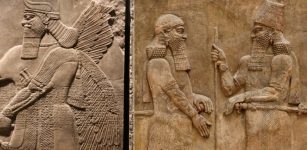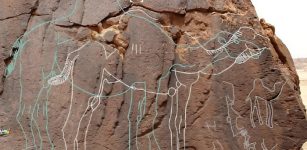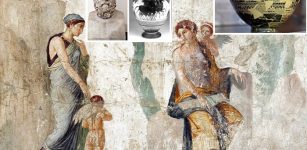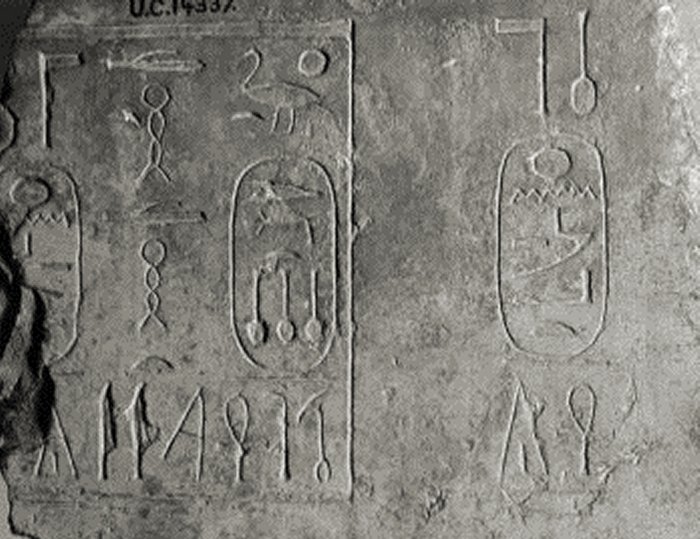Sobekneferu: First Female Pharaoh In Ancient Egypt
A. Sutherland - AncientPages.com - A number of rulers in ancient Egypt were named in honor of Sobek, an important ancient Egyptian deity of the 12th Dynasty, who was associated with the Nile crocodile or the West African crocodile.
One of such rulers was Sobekneferu (her name means "the beauty of Sobek") . She was the sister (or the sister-wife) of the last king, Amenemhet IV, the last ruler of the 12th Dynasty. Unquestionably, Sobekneferu, also known as Neferusobek was the first female pharaoh of Egypt. Her name was included in the Saqqara King List, probably dated to the reign of Ramses II (1290-1224 BC).
She took the throne after the death of her brother Amenemhat IV, a peaceful ruler who focused his ruling years on expeditions in the Sinai for turquoise, in Upper Egypt for amethyst, and to the Land of Punt.
Queen Sobekneferu was the royal daughter of Amenemhat III, whose reign is considered to be the golden age of the Middle Kingdom. Sobeknefeu was associated with Amenemhat III rather than her brother Amenemhat IV.
Sobekneferu ruled from 1806 to 1802 BC but according to the Turin Canon, an ancient Egyptian papyrus probably dated to the reign of Pharaoh Ramesses II, Sobekneferu ruled exactly three years, ten months, and twenty-four days. It is evident that she was the last pharaoh of the Twelfth Dynasty but not much can be said about the period of her reign.

Left: Bust of Sobekneferu (Louvre). Source; Right: Drawing by Flinders Petrie of the cylinder seal of Sobekneferu in the British Museum
It is known, however, that according to Egyptian tradition, Sobekneferu ruled independently and did not have a successor to claim the throne.
See also:
Shishak (Sheshonq I): Egyptian King Who Invaded Judah And United Egypt
Harem Conspiracy – Plot To Murder Ramesses III, The Last Great Warrior Pharaoh
Ankhesenamun – Mysterious Death Of Tutankhamun’s Wife Ended The True Amarna Bloodline
According to the Danish Egyptologist, Kim Ryholt, the contemporary sources from the time of her reign show that Sobekneferu never adopted the title of King's Sister-only "King's Daughter". Sobekneferu was never as popular as Pharaoh Hatshepsut and other ruling queens of ancient Egypt because she contributed with fewer monuments.
Death Of Pharaoh Sobekneferu
The death of Queen Sobekneferu marked the end of the Middle Kingdom. After her, a number of kings, mentioned in the Turin Canon papyrus, claimed their rights to the throne but ruled only for a shorter period of time.
These kings initiated the 13th Dynasty of rulers in ancient Egypt.
Legacy And Statues Of Sobekneferu
There have been unearthed statues related to Pharaoh Sobekneferu in places such Fayoum and Tell el-Daba, an archaeological site in the Nile delta region of Egypt where Avaris, the capital city of the Hyksos, was once located.
Inscription on the nilometer at Nubian Semna informs about only three years of her rule. An inscription from Hawara also mentions her name.
She is also credited for additions to the funerary complex of her father, Amenemhat III at Hawara (called a labyrinth by Herodotus), and also ordered the construction of structures at Heracleopolis Magna.
She is believed to have built a pyramid at Mazghuna, near Dahshur, on the west bank of the Nile about 40 kilometers (25 mi) south of Cairo. The Mazghuna structure was excavated by Flinders Petrie, an English Egyptologist in 1911. The pyramid has not been completed and never used.
Written by – A. Sutherland - AncientPages.com Senior Staff Writer
Copyright © AncientPages.com All rights reserved. This material may not be published, broadcast, rewritten or redistributed in whole or part without the express written permission of AncientPages.com
Expand for referencesMore From Ancient Pages
-
 Paris Catacombs: Huge Underground Labyrinth Full Of Secrets
Featured Stories | Jan 3, 2016
Paris Catacombs: Huge Underground Labyrinth Full Of Secrets
Featured Stories | Jan 3, 2016 -
 This Ancient Roman Painting Survived Eruption Of Mount Vesuvius In 79 A.D.
Archaeology | Aug 21, 2017
This Ancient Roman Painting Survived Eruption Of Mount Vesuvius In 79 A.D.
Archaeology | Aug 21, 2017 -
 Viking Era Sword Discovered By Young Girl
Archaeology | Oct 5, 2018
Viking Era Sword Discovered By Young Girl
Archaeology | Oct 5, 2018 -
 Steamship SS Mesaba Sent Warning To RMS Titanic In 1912 – Her Wreck is Now Identified
Archaeology | Sep 27, 2022
Steamship SS Mesaba Sent Warning To RMS Titanic In 1912 – Her Wreck is Now Identified
Archaeology | Sep 27, 2022 -
 On This Day In History: Eminent Scottish Inventor Graham Bell Born – On Mar 3, 1847
News | Mar 3, 2017
On This Day In History: Eminent Scottish Inventor Graham Bell Born – On Mar 3, 1847
News | Mar 3, 2017 -
 Dinosaurs Were The First To Take The Perspectives Of Others
Fossils | Jun 1, 2023
Dinosaurs Were The First To Take The Perspectives Of Others
Fossils | Jun 1, 2023 -
 Yehasuri – Little People Of South Carolina Living In The Woods – Native Americans’ Version Of Leprechauns
Featured Stories | Feb 26, 2019
Yehasuri – Little People Of South Carolina Living In The Woods – Native Americans’ Version Of Leprechauns
Featured Stories | Feb 26, 2019 -
 Treasure Trove Of Assyrian Kings Found In Tunnels Excavated And Plundered By Terrorists
Archaeology | Apr 20, 2020
Treasure Trove Of Assyrian Kings Found In Tunnels Excavated And Plundered By Terrorists
Archaeology | Apr 20, 2020 -
 On This Day In History: Teotihuacan’s Warlord Siyaj K’ak’ Conquers Tikal – On Jan 16, 378
News | Jan 16, 2017
On This Day In History: Teotihuacan’s Warlord Siyaj K’ak’ Conquers Tikal – On Jan 16, 378
News | Jan 16, 2017 -
 Beer And Hallucinogens Reinforced The State Of The Wari Culture
Archaeology | Jan 15, 2022
Beer And Hallucinogens Reinforced The State Of The Wari Culture
Archaeology | Jan 15, 2022 -
 Has The Mystery Of The Lost Trading Ship Zuytdorp Been Solved?
Archaeology | Dec 11, 2024
Has The Mystery Of The Lost Trading Ship Zuytdorp Been Solved?
Archaeology | Dec 11, 2024 -
 Remarkable Neolithic Life-Sized Camel Engravings Discovered In The Nefud Desert
Archaeology | Oct 5, 2023
Remarkable Neolithic Life-Sized Camel Engravings Discovered In The Nefud Desert
Archaeology | Oct 5, 2023 -
 Unexplained Historical Mass Disappearances – Lost Without Trace – Part 1
Featured Stories | May 31, 2019
Unexplained Historical Mass Disappearances – Lost Without Trace – Part 1
Featured Stories | May 31, 2019 -
 Archaeologists Discover Ancient Mayan Board Game – Here’s What It Can Teach Modern Educators
Featured Stories | May 19, 2023
Archaeologists Discover Ancient Mayan Board Game – Here’s What It Can Teach Modern Educators
Featured Stories | May 19, 2023 -
 Baffling Copper Scroll – A Treasure Map Leading To A Secret Lost Temple?
Featured Stories | Mar 17, 2018
Baffling Copper Scroll – A Treasure Map Leading To A Secret Lost Temple?
Featured Stories | Mar 17, 2018 -
 John Hawkwood ‘John Sharp’: Feared, English Mercenary And His White Company In 14th Century Italy
Featured Stories | Jun 20, 2020
John Hawkwood ‘John Sharp’: Feared, English Mercenary And His White Company In 14th Century Italy
Featured Stories | Jun 20, 2020 -
 Aphrodite Signified More Than Beauty – Five Other Realms In Which The Greek Goddess Also Reigned
Featured Stories | Sep 18, 2024
Aphrodite Signified More Than Beauty – Five Other Realms In Which The Greek Goddess Also Reigned
Featured Stories | Sep 18, 2024 -
 Remarkably Well-Preserved 2,500-Year-Old Canoe Discovered In Swiss Lake
Archaeology | Sep 16, 2023
Remarkably Well-Preserved 2,500-Year-Old Canoe Discovered In Swiss Lake
Archaeology | Sep 16, 2023 -
 Svarog: God Of Cosmic Fire And Ruler Of The Sky In Pre-Christian Slavic Pantheon
Featured Stories | Aug 15, 2017
Svarog: God Of Cosmic Fire And Ruler Of The Sky In Pre-Christian Slavic Pantheon
Featured Stories | Aug 15, 2017 -
 Mysterious Kaali Crater And The Holy Lake – Sacred Ancient Places In Estonia
Featured Stories | Jan 19, 2018
Mysterious Kaali Crater And The Holy Lake – Sacred Ancient Places In Estonia
Featured Stories | Jan 19, 2018

